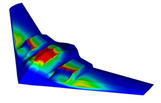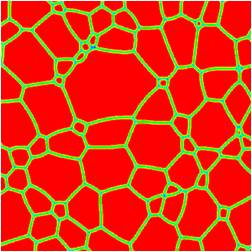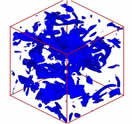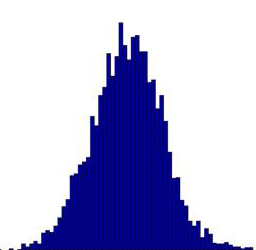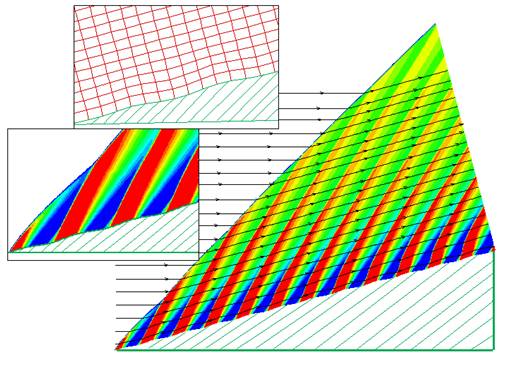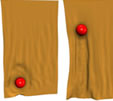EVENTS AND SEMINARS
2013
2012
MURI Annual Meeting, November 13, 2012
Multi-Scale Fusion of Information for Uncertainty Quantification and Management in Large Scale Simulations
Speakers and Presentations:
Heyrim Cho: Karhunen-Leove expansions for multi-correlated stochastic processes, PDF
George Karniadakis: Overview, PDF
Leo Ng: Multifidelity Uncertainty Propagation for Optimization Under Uncertainty, PDF
James Penn and Timo Ton: Design of Experiment and Uncertainty Quantification on Noisy Parametric Manifolds, Application to Material Identification
Boris Rozovsky: Wick-Malliavin approximation to SPDEs: Analysis and simulation, PDF
Nicholas Zabaras: Stochastic multiscale modeling: Bayesian interference, graphical models and cross entropy minimization, PDF
Masayuki Yano: A Space-Time Brezzi-Rappaz-Raviart Formulation for (Long-Time) Model Certification and Uncertainty Quantification; Application to Moderate Reynolds Number Flows, PDF
Shun Zhang: Reduced basis methods for high-dimensional parametric partial differential equations, PDF
Zhiwen Zhang: A dynamically bi-orthogonal method for time-dependent stochastic partial differential equations, PDF
November 16, 2012
Alex Mahalov
Arizona State University, Tempe, AZ
Stochastic 3D Rotating Navier-Stokes Equations: Averaging, Convergence, Regularity and Uncertainty Quantification.
August 3, 2012
Sorin Mitran
University of North Carolina, Chapel Hill, NC
Lattice Fokker-Planck Algorithm for Polymer Flows
July 27, 2012
Wanrong Cao
Southeast University, China
Introduction to Stochastic Delay Differential Equations: Models and Overview of Numerical Methods
July 13, 2012
Qinwu Xu
Central South University, China
High Order Numerical Methods for Fractional PDE
June 8, 2012
Xuan Zhao
Southwest University, China
Introduction to Time Fractional Diffusion Equations and the Corresponding Numerical Methods
May 18, 2012
Dionissios T. Hristopulos
Technical University of Crete, Greece
Spatial Random Fields based on Local Interactions and Applications to Spatial Interpolation
Workshop on Peridynamics, Dissipative Particle
Dynamics and the Mori-Zwanzig Formulation, April 10-11 2012
Stewart Silling
Peridynamics
George Karniadakis
Dissipative Particle Dynamics
Panos Stinis
Mori-Zwanzig Formulation
Richard Lehoucq
The Statistical Mechanical Foundation of the Peridynamic Nonlocal Continuum Theory: Energy and Momentum Conservation Laws
Qiang Du
Mathematical and Numerical Analysis of Peridynamic Models
Burak Aksoylu
Variational Theory, Conditioning, and Domain Decomposition for Nonlocal Problems
Nathanial Burch
A Survey of Nonlocal Diffusion Equations and the Underlying Jump Processes
Nikolaos Gatsonis
Perspectives on 3D Smooth Dissipative Particle Dynamics
Martin Nilsson Jacobi
Estimating Effective Force Fields in Dissipative Particle Dynamics
Jeremy Lechman
A Continuous Time Random Walk Description of Monodisperse, Hard-Sphere Colloids below the Ordering Transition
Michael Parks
Computational Peridynamics
Eric Darve
The Mori-Zwanzig Formalism and Stochastic Systems with Memory
Panos Stinis
Renormalized Reduced Models for Singular PDEs
Changho Kim
Microscopic Theory of Brownian Motion Revisited
Paul Spanos
Multiquadratic Radial Functions Basis for Spatial Discretization in Stochastic Peridynamic Analyses
Robert Lipton
Multi-scale Dynamics of Heterogeneous Media in the Peridynamic Formulation
Pablo Seleson
Concurrent coupling of nonlocal and local continuum models in peridynamic
Applied Mathematics Scientific Computing Seminar, April 13, 2012
Gianluca Iaccarino,Stanford Univeristy
Mechanical Engineering and Institute for Computational Mathematical Engineering
Simulations of Reactive Flows in Supersonic Combustion Chambers
Applied Mathematics Colloquium, February 9, 2012
Professor Terry Lyons
Oxford University, UK
The Expected Signature of a Stochastic Process: Some New PDE's
How can one describe a probability measure of paths? And how should one approximate to this measure so as to capture the effect of this randomly evolving system. Markovian measures were efficiently described by Stroock and Varadhan through the Martingale problem. But there are many measures on paths that are not Markovian and a new tool, the expected signature provides a systematic ways of describing such measures in terms of their effects. We explain how to calculate this expected signature I the case of the measure on paths corresponding to a Brownian motion started at a point x in the open set and run until it leaves the same set. A completely new (at least to the speaker) PDE is needed to characterise this expected signature. Joint work with Ni Hao.
Computational Seminar, February 9, 2012
Professor Terry Lyons, Oxford University
Cubature and Recombination of Path Space: New Approaches to Some Numerical Problems via Managed Populations of
Carefully Selected Scenarios
Particle methods are widely used in numerical approximations of systems because they can provide a realistic approach that allows the approximate description of an evolving measure. Recently it has become clear that by stepping outside the Monte-Carlo paradigm these methods can be of higher order with effective and transparent error bounds while preserving many of the other advantages (the maximum principal etc.). A weakness of particle methods (particularly in the higher order case) is the tendency for the number of particles to explode if the process is iterated and accuracy preserved. By introducing patching and dynamic recombination into such methods one can retain the high order accuracy and take advantage of the intrinsic smoothing property of many parabolic systems while simplifying the support of the intermediate measures used in the iteration. The methods are seriously heavy in computational terms per step but can blow away traditional adaptive methods where accurate solutions are required. The methods have been applied to PDE and Filtering problems with considerable success. Joint work with Nicolas Victoir, Christian Litterer, Wonjung Lee.
PAST EVENTS AND SEMINARS
2011
OSD/AFOSR MURI 2011 ANNUAL MEETING
Multi-Scale Fusion of Information for Uncertainty Quantification and Management in Large Scale Simulations
Monday, October 31, 2011
George Karniadakis: MURI overview PDF
Boris Rozovsky: Quantization of nonlinear stochastic PDEs and ODEs PDF
Thomas Hou: Stochastic multiscale modeling PDF
Themis Sapsis: New theory on joint PDE's PDF
George Karniadakis: High-Dimensional SPDEs PDF
Jan Hesthaven: Parametric compression through ANOVA PDF
Thomas Hou: Multi-level Monte Carlo method PDF
Nicholas Zabaras: Bayesian approaches to SPDEs PDF
Nicholas Zabaras: Multiscale parameter estimation PDF
Karen Willcox: Design under uncertainty PDF
Youssef Marzouk: Uncertainty quantification in inverse problems PDF
Tuesday, November 1, 2011
Tony Patera: Reduced order modeling PDF
Jan Hesthaven: Certified reduced basis methods for integral equations PDF
Phuong Huynh: Model uncertainty PDF
Kenny Chowdhary: Handling aleatoric and epistemic variation in UQ PDF
April 22, 2011
Xiaolong Wang
Department of Mathematics
Center for Computation and Technology
Louisiana State University
Baton Rouge, LA
Minimum Action Method and its Application to Study the Configuration Space
Minimum action method is based on the least action principle for random perturbations dynamical systems, which is important for the study of rare events induced by small noise. In this talk, we present a new version of the minimum action method, which couples spectral/hp finite element approximation of the minimal action path and a nonlinear conjugate gradient optimization solver, and discuss the numerical accuracy and efficiency. We also apply the minimum action method to study the transition of the Kuramoto-Sivashinsky equation.
2010
November, 12, 2010
Jean-Luc Guermond
Department of Mathematics
Texas A&M University
Division of Applied Mathematics, Brown University
Entropy-based artificial viscosity (PDF)
October 29 2010
Massachusetts Institute of Technology, Presentations:
Thomas Y. Hou (joint work with Mulin Cheng and Mike Yan). Data-Driven Stochastic Multiscale Method. PDF
Anthony T Patera. Parameter Estimation and Uncertainty A Reduced Basis Approach to Frequentistic Hypothesis Testing. PDF
R. Sternfels, P.S. Koutsourelakis, N. Zabaras (Cornell),
DBP Huynh, L Ng, C Lieberman, A Patera, K Willcox (MIT). A sequential approach to stochastic optimal
design using approximate/reduced-order
models. PDF
Xiang Ma and Nicholas Zabara. Kernel PCA for Stochastic Input Model
Reduction. PDF
Nicholas Zabaras and Jiang Wan. A Bayesian Approach to Multiscale Inverse Problems
Using Sequential Monte Carlo Method. PDF
January 29, 2010: Dr. M.H. Carpenter, NASA Langley Research Center
February 12, 2010: Jia Li, Division of Applied Mathematics, Brown University
On Numerical Properties of Data Assimilation Methods
Abstract: Data assimilation methods have been studied extensively in the recent years and used in many applications, as a means of addressing uncertainty in models. Among many approaches, Ensemble Kalman filter (EnKF) and particle filter (PF) are two important data assimilation methods that have been widely used in practice, primarily due to their ease of implementation. In this talk, we present analysis on the numerical errors of the two filters, e.g., error bounds and convergence rate. We also propose algorithms to enhance the efficiency of the EnKF: one based on deterministic sampling strategy and the other on the general polynomial chaos methodology. Numerical examples are provided to verify the theoretical results and demonstrate the performance of the new proposed filter methods.
March 12, 2010: Dr. Henry Boateng, Department of Mathematics
University of Michigan, Ann Arbor, MI
Cartesian Treecode Algorithms for Molecular Dynamics Simulations
Abstract: The focus of this work is on speeding up electrostatic interactions in
molecular dynamics (MD) simulations of polar systems. Explicit particle-particle interactions typically cost O(N^2) in computation time which becomes prohibitive for large systems. We will present our work on the development and application of Barnes-Hut/Appel type treecode algorithms aimed at speeding up the computation of coulombic interactions and Ewald sums. We will expound on our present efforts to develop an alternative/addition to the popular particle-mesh Ewald method and present results from MD simulations of liquid methyl chloride that validates the treecode algorithm.
March 26, 2010, D. Estep, Colorado State University
A Measure Theoretic Computational Approach For Inverse Sensitivity Problems
Abstract: We describe a computational method for probabilistic inverse sensitivity analysis of a map from a set of parameters and data to a computed quantity of interest. The inverse problem is to describe the random variation in the input and parameters that lead to an imposed or observed random variation on the output quantity. To complicate matters, we are interested in implicitly-defined maps, such as a quantity of interest computed from the solution of a differential equation. We formulate the problem as an ill-posed inverse problem for an integral equation using the Law of Total Probability and then describe a computational method for computing solutions. The method has two stages. In the first part, we approximate the unique set-valued solution to the inverse of the integral equation using derivative information. In the second part, we apply basic ideas from measure theory to compute the approximate probability measure on the parameter and data space that solves the integral equation. We discuss convergence of the method, and explain how to use the method to compute the probability of events in the input (parameter) space. The talk is illustrated with a number of examples. Time permitting, we discuss briefly the numerical analysis (accuracy) of the method and the consideration of multiple quantities of interest and data assimilation.
July 2010 Annual Meeting Presentations
J Hesthaven, 2-D Scattering by open cavity. PDF
AT Patera, K Willcox, DBP Huynh, DJ Knezevic, JS Hesthaven, Y Chen, B Stamm, Reduced Basis Basics and Inverse Problems In-Situ Assessment of Parameter Uncertainty Acoustic Impedance “Measurement" PDF
Multi-Scale Fusion of Information for Uncertainty Quantification and Management in Large-Scale Simulations PDF
DBP Huynh, C Lieberman, A Patera, K Willcox, PS Koutsourelakis, R Sternfels, J Hesthaven, Design/Control Under Uncertainty: Decisions that Account for Discretization Error, Parameter Uncertainty and Parametric Variability PDF
July 6, 2010: Themistoklis Sapsis, Department of Mechanical Engineering
Massachusetts Institute of Technology
Dynamically Orthogonal Field Equations for Stochastic Fluid Flows
Abstract: In the past decades an increasing number of problems in continuum theory have been treated using stochastic dynamical theories. This is because dynamical systems governing real processes always contain some elements characterized by uncertainty or stochasticity. Uncertainties may arise in the system parameters, the boundary and initial conditions, and also in the external forcing processes. Also, many problems are treated through the stochastic framework due to the incomplete or partial understanding of the governing physical laws. In all of the above cases the existence of random perturbations, combined with the complex dynamical mechanisms of the system often leads to their rapid growth which causes distribution of energy to a broadband spectrum of scales both in space and time, making the system state particularly complex. Such problems are mainly described by Stochastic Partial Differential Equations and they arise in a number of areas including fluid mechanics, elasticity, and wave theory, describing phenomena such as turbulence, random vibrations, flow through porous media, and wave propagation through ran dom media. This is but a partial listing of applications and it is clear that almost any phenomenon described by a field equation has an important subclass of problems that may profitably be treated from a stochastic point of view. In this work, we develop a new methodology for the representation and evolution of the complete probabilistic response of infinite-dimensional, random, dynamical systems. More specifically, we derive an exact, closed set of evolution equations for general nonlinear continuous stochastic fields described by a Stochastic Partial Differential Equation. The derivation is based on a novel condition, the Dynamical Orthogonality (DO), on the representation of the solution. This condition is the `key' to overcome the redundancy issues of the full representation used while it does not restrict its generic features. Based on the DO condition we derive a system of field equations consisting of a Partial Differential Equation (PDE) for the mean field, a family of PDEs for the orthonormal basis that describe the stochastic subspace where uncertainty `lives' as well as a system of Stochastic Differential Equations that defines how the uncertainty evolves in the time varying stochastic subspace. If additional restrictions are assumed on the form of the representation, we recover both the Proper-Orthogonal-Decomposition (POD) equations and the generalized Polynomial-Chaos (PC) equations; thus the new methodology generalizes these two approaches. For the efficient treatment of the strongly transient character on the systems described above we derive adaptive criteria for the variation of the stochastic dimensionality that characterizes the system response. Those criteria follow directly from the dynamical equations describing the system. We illustrate and validate this novel technique by solving the 2D stochastic Navier-Stokes equations in various geometries and compare with direct Monte Carlo simulations. We also apply the derived framework for the study of the statistical responses of an idealized `double gyre' model, which has elements of ocean, atmospheric and climate instability behaviors.
October 8, 2010: Zhongqiang Zhang
Brown University, Division of Applied Mathematics
Spectral Separating Scheme for Passive Scalar Equation: Long-term Integration PDF
October 15, 2010: Wanrong Cao, Southeast University, China
Numerical Method for Stochastic Delay Differential Equations PDF
October 15, 2010: Dongbin Xiu, Purdue University
Efficient Algorithm for Computing Rare Failure Probability
Abstract: Evaluation of failure probability is a fundamental task in many important applications such as aircraft design, risk management, etc. Mathematically it can be formulated easily as integrals. The difficulty lies in the fact that the integrals are usually of high dimensions and more importantly the geometry is irregular and known only through simulations of some complex systems under consideration. In practical applications when full-scale simulations are time consuming, there exists no effective methods to accurately compute failure probability. The situation is more severe when dealing with rare failure probability, i.e, failure probability less than 10^-5. In this work we discuss the strength and limitation of the existing popular methods. We further present an efficient algorithm to simulate failure probability accurately at very low simulation cost. The algorithm is able to capture rare failure probability with only a few hundreds simulations and is suitable for practical complex system. Both mathematical analysis and numerical examples are provided.
2009
September 25, 2009: Dr. A. Matzavinos, Iowa State University
Abstract: Spectral Clustering Methods in Data Processing and Image Analysis.
The need to interpret and extract possible inferences from high-dimensional datasets has led over the past decades to the development of dimensionality reduction and data clustering techniques. Scientific and technological applications of clustering methodologies include among others computer imaging, data mining and bioinformatics. Current research in data clustering focuses on identifying and exploiting information on dataset geometry and on developing robust algorithms for noisy datasets. Recent approaches based on spectral graph theory have been devised to efficiently handle dataset geometries exhibiting a manifold structure, and fuzzy clustering methods have been developed that assign cluster membership probabilities to data that cannot be readily assigned to a specific cluster. In this talk, we develop a novel fuzzy spectral clustering algorithm that combines seamlessly the strengths of spectral approaches to clustering with various desirable properties of fuzzy methods. The developed methodology is applied to image segmentation and registration problems. (In collaboration with Philip K. Maini, Radek Erban, and Ornella Cominetti of the University of Oxford.) (View presentation.)
October 16, 2009: Dr. Elisabeth Ullmann, TU Bergakademie Freiberg, Germany
Preconditioning Stochastic Galerkin Saddle Point Systems. Abstract: We study efficient iterative solvers for Galerkin equations associated with mixed finite element discretizations of second-order elliptic partial differential equations (PDEs) with random coefficient functions. Such systems arise, for example, from discretized Darcy flow problems with random permeability coefficients. The Galerkin matrix has a familiar saddle point structure, however, due to the coupling of (standard) mixed finite element discretizations in the physical space and global polynomial chaos approximations on a probability space, the number of unknowns is huge. Moreover, the leading blocks of the saddle point matrix are sums of Kronecker products of pairs of matrices associated with the physical and stochastic discretization, respectively. Depending on the models employed for the random coefficient function, this block can be block-dense, and the cost of a matrix-vector product is non-trivial.We analyze block-diagonal preconditioners of Schur complement and augmented type for use with MINRES. First, we consider an inexpensive mean-based preconditioner based on fast solvers for scalar diffusion problems. For stochastically linear random coefficient functions, which arise, for example, from a truncated Karhunen-Loève expansion, with moderate fluctuations in the data relative to the mean value, we demonstrate that this gives an efficient way for solving the large coupled Galerkin system. If, on the other hand, the random diffusion coefficient is a lognormal random field approximated via a nonlinear function of random parameters, mean-based preconditioners are not effective. For this case, we combine so-called Kronecker product preconditioners with the Schur complement and augmented preconditioning approach, respectively. We study the spectral properties of the preconditioned saddle point matrix and demonstrate numerically the improved robustness of the Kronecker product preconditioners compared to the mean-based approach with respect to key statistical parameters of the random diffusion coefficient. This is joint work with Catherine Powell, David Silvester (Manchester, UK) and Oliver Ernst (Freiberg, Germany). PDF
October 23, 2009: Professor Marcus Sarkis, Worcester Polytechnic Institute
Finite element approximations of the Darcy’s equation in random porous media. Abstract: In this talk we consider a stochastic Darcy's pressure equation with random permeability and random right-hand side forcing term. I will discuss an infinity-dimensional Petrov-Galerkin framework to accommodate the lack of ellipticity and singular forcing terms. The framework unify both representations of permeability stochastic fields based on KL or on convolution kernels. We present continuous and discrete inf-sup conditions, well-posedness, a priori error estimations and numerical experiments. PDF
October 30, 2009: OSD/AFOSR MURI KICK-OFF MEETING, Multi-Scale Fusion of Information for Uncertainty Quantification and Management in Large Scale Simulations
November 13, 2009: Dr. Y. Marzouk, MIT
Computationally Efficient Bayesian Inference Using Polynomial Chaos Expansions. Abstract: Predictive simulation of complex engineering systems increasingly rests on the interplay of experimental observations with computational models. Key inputs, parameters, or structural aspects of models may be incomplete or unknown, and must be developed from indirect and limited observations. At the same time, quantified uncertainties are needed to qualify computational predictions in the support of design and decision-making. In this context, Bayesian statistics provides a foundation for inference from noisy and limited data. Computationally intensive forward models, however, can render a Bayesian approach prohibitive. Polynomial chaos expansions, typically used in the forward propagation of uncertainty, are an extremely useful tool in the inverse context as well. We introduce a stochastic spectral formulation that accelerates the Bayesian solution of inverse problems via rapid evaluation of a surrogate posterior distribution. The posterior is constructed by either stochastic collocation or stochastic Galerkin methods. Theoretical convergence results are verified with several numerical examples---in particular, parameter estimation in transport equations and in chemical kinetic systems. We also extend this approach to the inference of spatially distributed quantities in a hierarchical Bayesian setting, achieving dimensionality reduction via Karhunen-Loeve representations of Gaussian process priors. Finally, we discuss the utility of polynomial chaos expansions in optimal experimental design---choosing experimental conditions to maximize information gain in parameters or outputs of interest. A Bayesian formulation of the design problem fully accounts for uncertainty in the parameters and relevant observables.PDF
November 20, 2009: Dr. Y. Cao, Auburn University. Brownian sheet and elliptic SPDE.
(View presentation) |
